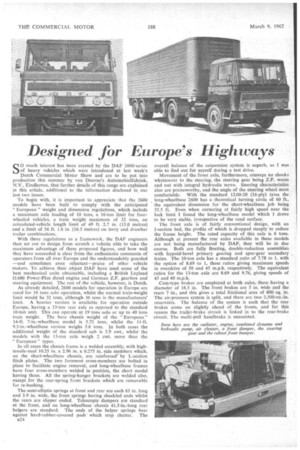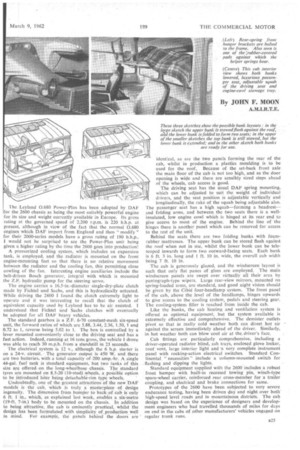Designed for Europe's Highways
Page 58

Page 59

If you've noticed an error in this article please click here to report it so we can fix it.
By JOHN F. MOON
SO much interest has been created by the DAF 2600-series of heavy vehicles which were introduced at last week's Dutch Commercial Motor Show and are to be put into production this summer by van Doome's Automobielfabriek, N.Y., Eindhoven, that further details of this range are explained in this article, additional to the information disclosed in our last two issues.
To begin with, it is important to appreciate that the 2600 models have been built to comply with the anticipated "European" weight and dimension regulations, which include a maximum axle loading of 10 tons, a 16-ton limit for fourwheeled vehicles, a train weight maximum of 32 tons, an articulated-vehicle length limit of 49 ft. 2.7 in. (15.0 metres) and a limit of 54 ft. 1.6 in. (16.5 metres) on lorry and drawbar trailer combinations.
With these regulations as a framework, the DAP engineers then set out to design from scratch a vehicle able to take the maximum advantage of these proposed figures, and how well they have succeeded is clear from the enthusiastic comments of operators from all over Europe and the understandably guarded —and sometimes even reluctant—praise of other vehicle makers. To achieve their object DAF have used some of the best mechanical units obtainable, including a British Leyland 0.680 Power-PIus diesel engine and German Z.F. gearbox and steering equipment The rest of the vehicle, however, is Dutch.
As already detailed, 2600 models for operation in Europe are rated for 16 tons solo operation, whilst the normal train-weight limit would be 32 tons, although 36 tons is the manufacturers' limit. A heavier version is available for operation outside Europe, having a 13-ton rear axle as opposed to the standard 10-ton unit. This can operate at 19 tons solo or up to 40 tons train weight. The bare chassis weight of the "European" 14-ft. 7-in.-wheelbase model is 5.75 tons, whilst the I1-ft. 9.5-in.-wheelbase version weighs 5.6 tons. In both cases the additional weight of the standard cab is 5.9 cwt., whilst the models with the 13-ton axle weigh 2 cwt. more than the "European" types.
In all cases the chassis frame is a welded assembly, with hightensile-steel 10.25 in. x 2.96 in. x 0.275 in. side members which, on the short-wheelbase chassis, are reinforced by L-section flitch plates. The two foremost cross-members are bolted in place to facilitate engine removal, and long-wheelbase frames have four cross-members welded in position, the short model having three. All the spring-hanger brackets are welded also, except for the rear-spring front brackets which are removable for re-bushing.
The semi-elliptic springs at front and rear are each 63 in. long and 3.9 in. wide, the front springs having shackled ends whilst the rears are slipper ended. Telescopic dampers are standard at the front, and on long-wheelbase chassis 41.5-in.-long rear helpers are standard. The ends of the helper springs bear against hard-rubber-covered pads" which stop chatter. The overall balance of the suspension system is superb, as I was able to find out for myself during a test drive.
Movement of the front axle, furthermore, conveys no shocks whatsoever to •the steering, the steering gear being Z.F. worm and nut with integral hydraulic servo. Steering characteristics also are praiseworthy, and the angle of the steering wheel most comfortable. With the standard 12.00-20 (16-ply) tyres the long-wheelbase 2600 has a theoretical turning circle of 60 ft, the equivalent dimension for the short-wheelbase job being 55.5 ft. Even when cornering at fairly high speed near the lock limit I found the long-wheelbase model which I drove to be very stable, irrespective of the road surface.
The front axle is of fairly conventional design, with an I-section bed, the profile of which is dropped steeply to reduce the frame height. The rated capacity of this axle is 6 tons. Although at present the rear axles available in these models are not being manufactured by DAF, they will be in due course. Both are fully floating, double-reduction assemblies with hypoid-bevel primary gearing and spur-gear secondary trains. The 10-ton axle has a standard ratio of 7.78 to 1, with the option of 8.69 to 1, these ratios giving maximum speeds in overdrive of 50 and 45 m.p.h. respectively. The equivalent ratios for the 13-ton axle are 8.69 and 9.76, giving speeds of 45 and 40 m.p.h.
Cam-type brakes are employed at both axles, these having a diameter of 16.5 in. The front brakes are 5 in. wide and the rears 7 .in., and this gives a total frictional area of 800 sq. in. The air-pressure system is split, and there are two 2,500-cu.-in. reservoirs. The balance of the system is such that the rear brakes come on slightly ahead of the fronts, and for this reason the trailer-brake circuit is linked in to the rear-brake circuit. The muiti-pull handbrake is unassisted. The Leyland 0.680 Power-Plus has been adopted by DAF for the 2600 chassis as being the most suitably powerful engine for its size and weight currently available in Europe. Its gross rating at the governed speed of 2,200 r.p.m. is 220 b.h.o. at present, although in view of the fact that the normal '0.680 engines which DAF import from England and then " modify" for their 2000-series models have a gross rating of 190 b.h.p., I would not be surprised to see the Power-Plus unit being given a higher rating by the time the 2600 goes into production!
A pressurized cooling system, which includes an expansion tank, is employed, and the radiator is mounted on the front engine-mounting feet so that there is no relative movement between the radiator and the cooling fan, this permitting close cowling of the fan. Interesting engine auxiliaries include the belt-driven Bosch generator, integral with which is mounted the Z.F. hydraulic pump for the steering servo.
The engine carries a 16.5-in.-diameter single-dry-plate clutch made by Fichtel und Sachs, and this is hydraulically actuated. While driving the 2600 I found the clutch extremely light to operate and it was interesting to recall that the clutch of equivalent capacity used by Leyland has to be air assisted. I understand that Fichte] und Sachs clutches will eventually be adopted for all DAF heavy vehicles.
The standard gearbox is a Z.F. 6-70 constant-mesh six-speed unit, the forward ratios of which are 5.88, 3.44, 2.36, 1.50, 1 and 0.72 to 1, reverse being 5.02 to 1. The box is controlled by a lever mounted conveniently close to the driving seat and has a fast action. Indeed, running at 16 tons gross, the vehicle I drove was able to reach 30 m.p.h. from a standstill in 23 seconds.
. The electrical system is 12 v., although the 6 h.p. starter is on a 24-v. circuit. The generator output is 450 W. and there are two batteries, with a total capacity of .200 amp-hr. A single 44-gal. fuel tank is standard equipment, but two tanks of this size are offered. on. the long-wheelbase• chassis. The standard tyres are mounted on 8.5-20 (l0-stud) wheels, a possible option to be introduced later being detachable rimtype wheels.
Undoubtedly, one of the greatest.attractions of the new. DAF models is the cab, which is truly a masterpiece of design ingenuity. The dimension from .bumr:er to back .of -cab is.onlY 6 ft. 1 in., which, as explained last Week, enables a six-mitre (19-ft. 7-in.) body to be mounted on the chassis. In addition to being attractive, the cab is eminently practical, whilst the design has been formulated with simplicity of:.production well
in mind. For example, the panels behind the doors are idenfeal, as are the two panels forming the rear of the cab, whilst in production a plastics moulding is . to be used for the roof. Because of the set-back front axle the main floor of the cab is not too high, and as the door opening is wide and there are sensibly sized steps ahead of the wheels, cab access is good.
The driving seat has the usual DAF spring mounting, which can be adjusted to suit the weight of individual drivers, and the seat position is adjustable vertically and longitudinally, the rake of the squab being adjustable also. The passenger seat has a high. squab—forming a headrest-and folding arms, and between the two seats there is a wellinsulated, low engine cowl which is hinged at its rear end to give access to most of the engine. Behind the line or the hinges there is another panel which can be removed for access to the rest of the unit.
Behind the seats there are two folding bunks with foamrubber mattresses. The upper bunk can be stored flush against the roof when not in use, whilst the lower bunk can be telescoped inwards to form two outward-facing seats. Each bunk is 6 ft. 3 in. long and 1 ft. 10 in. wide, the overall cab width being 7 ft. 10 in.
The cab is generously glazed, and the windscreen layout is such that only fiat panes of glass are employed, The main windscreen panels are swept over virtually all their area by pantograph-type wipers. Large rear-view mirrors, mounted on spring-loaded arms, are standard, and good night vision should be given by the Cibie four-headlamp system. The front panel of the cab, above the level of the headlamps, hinges upwards to give access to the 'cooling system, pedals and steering gear. The cooling-system filler is reached from inside the cab.
Like the bunks, the cab heating and ventilation system is offered as optional equipment, but the system available is extremely effective and comprehensive. The demister outlets pivot so that in really cold weather both can direct hot air against the screen immediately ahead of the driver. Similarly, in hot weather both can blow cool air at the driver's face.
Cab fittings are particularly comprehensive, including a driver-operated radiator blind, ash trays, enclosed glove locker, roof vent, large interior light and -a .very cornPlete instrument panel with rocking-action electrical switches. Standard Continental "necessities" include a column-mounted switch for flashing and dipping the lights.
. Standard equipment supplied with the 2600 includes a robust front bumper with built-in recessed towing pin, winch-type spare-wheel carrier, reinforced rear cross-member for a trailer coupling, and electrical and brake connections for same.
Prototypes of the 2600 have been subjected to very severe endurance testing, having been driven day and night over both high-speed level roads and in mountainous districts. The cab design was based on the experience of designers and development engineers who had travelled thousands of miles for days on end in the cabs of other manufacturers' vehicles engaged on regular trunk runs.




































































































































